Effects of Biophysical Factors on Light Use Efficiency at Multiple Time Scales in a Chinese Cork Oak Plantation Ecosystem
Abstract
:1. Introduction
2. Materials and Methods
2.1. Study Area
2.2. Measurement
2.3. Data Proceeding
2.3.1. Flux Data
2.3.2. Light Use Efficiency
2.3.3. Evaporative Fraction
2.3.4. Clearness Index
2.3.5. PAR Partitioning
2.4. Statistical Analyses
2.4.1. Path Analyses
2.4.2. Other Statistical Analyses
3. Results
3.1. LUE at the 30 min Time Scale and Influencing Factors
3.2. LUE at the Daily Time Scale and Influencing Factors
3.3. LUE at the Monthly Time Scale and Influencing Factors
3.4. LUE at the Annual Time Scale and Influencing Factors
4. Discussion
4.1. Variations in LUE at Different Time Scales
4.2. Effect of Biophysical Factors on LUE at Different Time Scales
5. Conclusions
Author Contributions
Funding
Data Availability Statement
Acknowledgments
Conflicts of Interest
Appendix A
References
- Ruimy, A.; Jarvis, P.G.; Baldocchi, D.D.; Saugier, B. CO2 fluxes over plant canopies and solar radiation: A review. Adv. Ecol. Res. 1995, 26, 1–68. [Google Scholar] [CrossRef]
- Zhang, L.; Cao, P.; Zhu, Y.; Li, Q.; Zhang, J.; Wang, X.; Dai, G.; Li, J. Dynamics and regulations of ecosystem light use efficiency in a broad-leaved Korean pine mixed forest, Changbai Mountain. Chin. J. Plant Ecol. 2015, 39, 1156–1165. [Google Scholar] [CrossRef]
- Garbulsky, M.F.; Peñuelas, J.; Papale, D.; Ardö, J.; Goulden, M.L.; Kiely, G.; Richardson, A.D.; Rotenberg, E.; Veenendaal, E.M.; Filella, I. Patterns and controls of the variability of radiation use efficiency and primary productivity across terrestrial ecosystems. Glob. Ecol. Biogeogr. 2010, 19, 253–267. [Google Scholar] [CrossRef]
- Jenkins, J.P.; Richardson, A.D.; Braswell, B.H.; Ollinger, S.V.; Hollinger, D.Y.; Smith, M.L. Refining light-use efficiency calculations for a deciduous forest canopy using simultaneous tower-based carbon flux and radiometric measurements. Agric. For. Meteorol. 2007, 143, 64–79. [Google Scholar] [CrossRef]
- Fei, X.; Song, Q.; Zhang, Y.; Yu, G.; Zhang, L.; Sha, L.; Liu, Y.; Xu, K.; Chen, H.; Wu, C. Patterns and controls of light use efficiency in four contrasting forest ecosystems in Yunnan, Southwest China. J. Geophys. Res.-Biogeosci. 2019, 124, 293–311. [Google Scholar] [CrossRef]
- Yuan, W.; Cai, W.; Xia, J.; Chen, J.; Liu, S.; Dong, W.; Merbold, L.; Law, B.; Arain, A.; Beringer, J.; et al. Global comparison of light use efficiency models for simulating terrestrial vegetation gross primary production based on the LaThuile database. Agric. For. Meteorol. 2014, 192–193, 108–120. [Google Scholar] [CrossRef]
- Tang, X.G.; Li, H.P.; Huang, N.; Li, X.Y.; Xu, X.B.; Ding, Z.; Xie, J. A comprehensive assessment of MODIS-derived GPP for forest ecosystems using the site-level FLUXNET database. Environ. Earth Sci. 2015, 74, 5907–5918. [Google Scholar] [CrossRef]
- Zhou, Y.; Wu, X.; Ju, W.; Chen, J.M.; Wang, S.; Wang, H.; Yuan, W.; Black, T.A.; Jassal, R.; Ibrom, A.; et al. Global parameterization and validation of a two-leaf light use efficiency model for predicting gross primary production across FLUXNET sites. J. Geophys. Res.-Biogeosci. 2016, 121, 1045–1072. [Google Scholar] [CrossRef]
- Gilmanov, T.G.; Aires, L.; Barcza, Z.; Baron, V.S.; Belelli, L.; Beringer, J.; Billesbach, D.; Bonal, D.; Bradford, J.; Ceschia, E.; et al. Productivity, respiration, and light-response parameters of world grassland and agroecosystems derived from flux-tower measurements. Rangel. Ecol. Manag. 2010, 63, 16–39. [Google Scholar] [CrossRef]
- Shi, H.; Li, L.H.; Eamus, D.; Cleverly, J.; Huete, A.; Beringer, J.; Yu, Q.; Van Gorsel, E.; Hutley, L. Intrinsic climate dependency of ecosystem light and water-use-efficiencies across Australian biomes. Environ. Res. Lett. 2014, 9, 104002. [Google Scholar] [CrossRef]
- Gilmanov, T.G.; Soussana, J.F.; Aires, L.; Allard, V.; Ammann, C.; Balzarolo, M.; Barcza, Z.; Bernhofer, C.; Campbell, C.L.; Cernusca, A.; et al. Partitioning European grassland net ecosystem CO2 exchange into gross primary productivity and ecosystem respiration using light response function analysis. Agric. Ecosyst. Environ. 2007, 121, 93–120. [Google Scholar] [CrossRef]
- Taylor, A.M.; Amiro, B.D.; Fraser, T.J. Net CO2 exchange and carbon budgets of a three-year crop rotation following conversion of perennial lands to annual cropping in Manitoba, Canada. Agric. For. Meteorol. 2013, 182, 67–75. [Google Scholar] [CrossRef]
- He, H.; Liu, M.; Xiao, X.; Ren, X.; Zhang, L.; Sun, X.; Yang, Y.; Li, Y.; Zhao, L.; Shi, P.; et al. Large-scale estimation and uncertainty analysis of gross primary production in Tibetan alpine grasslands. J. Geophys. Res.-Biogeosci. 2014, 119, 466–486. [Google Scholar] [CrossRef]
- Nagler, P.L.; Glenn, E.P.; Nguyen, U.; Scott, R.L.; Doody, T. Estimating riparian and agricultural actual evapotranspiration by reference evapotranspiration and MODIS enhanced vegetation index. Remote Sens. 2013, 5, 3849–3871. [Google Scholar] [CrossRef]
- Alberti, G.; Vedove, G.D.; Zuiliani, M.; Peressotti, A.; Castaldi, S.; Zerbi, G. Changes in CO2 emissions after crop conversion from continuous maize to alfalfa. Agric. Ecosyst. Environ. 2010, 136, 139–147. [Google Scholar] [CrossRef]
- O’Connell, K.E.B.; Gower, S.T.; Norman, J.M. Comparison of net primary production and light-use dynamics of two boreal black spruce forest communities. Ecosystems 2003, 6, 236–247. [Google Scholar] [CrossRef]
- Coops, N.C.; Hilker, T.; Hall, F.G.; Nichol, C.J.; Drolet, G.G. Estimation of light-use efficiency of terrestrial ecosystems from space: A status report. Bioscience 2010, 60, 788–797. [Google Scholar] [CrossRef]
- Onoda, Y.; Saluñga, J.B.; Akutsu, K.; Aiba, S.; Yahara, T.; Anten, N.P.R. Trade-off between light interception efficiency and light use efficiency: Implications for species coexistence in one-sided light competition. J. Ecol. 2014, 102, 167–175. [Google Scholar] [CrossRef]
- Kanniah, K.D.; Beringer, J.; North, P.; Hutley, L. Control of atmospheric particles on diffuse radiation and terrestrial plant productivity: A review. Prog. Phys. Geogr. 2012, 36, 209–237. [Google Scholar] [CrossRef]
- Schwalm, C.R.; Black, T.A.; Amiro, B.D.; Arain, M.A.; Barr, A.G.; Bourque, C.P.A.; Dunn, A.L.; Flanagan, L.B.; Giasson, M.A.; Lafleur, P.M.; et al. Photosynthetic light use efficiency of three biomes across an east-west continental-scale transect in Canada. Agric. For. Meteorol. 2006, 140, 269–286. [Google Scholar] [CrossRef]
- Still, C.J.; Randerson, J.T.; Fung, I.Y. Large-scale plant light-use efficiency inferred from the seasonal cycle of atmospheric CO2. Glob. Chang. Biol. 2004, 10, 1240–1252. [Google Scholar] [CrossRef]
- Forrester, D.I.; Collopy, J.J.; Beadle, C.L.; Baker, T.G. Effect of thinning, pruning and nitrogen fertiliser application on light interception and light-use efficiency in a young Eucalyptus nitens plantation. For. Ecol. Manag. 2013, 288, 21–30. [Google Scholar] [CrossRef]
- Martin, T.A.; Jokela, E.J. Developmental patterns and nutrition impact radiation use efficiency components in southern pine stands. Ecol. Appl. 2004, 14, 1839–1854. [Google Scholar] [CrossRef]
- Chasmer, L.; Mccaughey, H.; Barr, A.; Black, A.; Shashkov, A.; Treitz, P.; Zha, T. Investigating light-use efficiency across a jack pine chronosequence during dry and wet years. Tree Physiol. 2008, 28, 1395–1406. [Google Scholar] [CrossRef] [PubMed]
- Zhao, M.; Running, S.W. Drought-induced reduction in global terrestrial net primary production from 2000 through 2009. Science 2010, 329, 940–943. [Google Scholar] [CrossRef] [PubMed]
- Zhu, X.; Yu, G.; Wang, Q.; Gao, Y.; He, H.; Zheng, H.; Chen, Z.; Shi, P.; Zhao, L.; Li, Y.; et al. Approaches of climate factors affecting the spatial variation of annual gross primary productivity among terrestrial ecosystems in China. Ecol. Indic. 2016, 62, 174–181. [Google Scholar] [CrossRef]
- Zhang, Y.; Zhu, W. On advances in light use efficiency of forest. J. Southwest China Norm. U. 2018, 43, 18–24. [Google Scholar] [CrossRef]
- Zhang, L.; Yu, G.; Sun, X.; Wen, X.; Ren, C.; Fu, Y.; Li, Q.; Li, Z.; Liu, Y.; Guan, D.; et al. Seasonal variations of ecosystem apparent quantum yield (α) and maximum photosynthesis rate (Pmax) of different forest ecosystems in China. Agric. For. Meteorol. 2006, 137, 176–187. [Google Scholar] [CrossRef]
- Zhang, L.; Zhou, D.; Fan, J.; Hu, Z. Comparison of four light use efficiency models for estimating terrestrial gross primary production. Ecol. Model. 2015, 300, 30–39. [Google Scholar] [CrossRef]
- Ma, J.; Jia, X.; Zha, T.; Bourque, C.; Tian, Y.; Bai, Y.; Liu, P.; Yang, R.; Li, C.; Li, C.; et al. Ecosystem water use efficiency in a young plantation in Northern China and its relationship to drought. Agric. For. Meteorol. 2019, 275, 1–10. [Google Scholar] [CrossRef]
- Yebra, M.; Van Dijk, A.; Leuning, R.; Guerschman, J.P. Global vegetation gross primary production estimation using satellite-derived light-use efficiency and canopy conductance. Remote Sens. Environ. 2015, 163, 206–216. [Google Scholar] [CrossRef]
- Che, Y.; Kong, Y.; Song, S.; Yi, X.; Zhou, J.; Liu, B. Effect of cork flour supplementation on the growth indices and rhizosphere bacterial communities of Quercus variabilis seedlings. Forests 2023, 14, 892. [Google Scholar] [CrossRef]
- Jiang, L.; Peng, Z.; He, B.; Hou, Z.; Du, Y. Caloric values and ash contents of Quercus variabilis at five different ages. J. Nanjing Forestry U. 2011, 35, 40–44. [Google Scholar] [CrossRef]
- Tong, X.; Zhang, J.; Meng, P.; Li, J.; Zheng, N. Ecosystem water use efficiency in a warm-temperate mixed plantation in the North China. J. Hydrol. 2014, 512, 221–228. [Google Scholar] [CrossRef]
- Gu, L.H.; Fuentes, J.D.; Shugart, H.H.; Staebler, R.M.; Black, T.A. Responses of net ecosystem exchanges of carbon dioxide to changes in cloudiness: Results from two North American deciduous forests. J. Geophys. Res.-Atmos. 1999, 104, 31421–31434. [Google Scholar] [CrossRef]
- Gao, X.; Gu, F.; Mei, X.; Hao, W.; Li, H.; Gong, D.; Li, X. Light and water use efficiency as influenced by clouds and/or aerosols in a rainfed spring maize cropland on the loess plateau. Crop Sci. 2018, 58, 853–862. [Google Scholar] [CrossRef]
- Gong, X.; Qiu, R.; Sun, J.; Ge, J.; Li, Y.; Wang, S. Evapotranspiration and crop coefficient of tomato grown in a solar greenhouse under full and deficit irrigation. Agr. Water Manag. 2020, 235, 106154. [Google Scholar] [CrossRef]
- Agam, N.; Cohen, Y.; Berni, J.; Alchanatis, V.; Kool, D.; Dag, A.; Yermiyahu, U.; Ben-Gal, A. An insight to the performance of crop water stress index for olive trees. Agric. Water Manag. 2013, 118, 79–86. [Google Scholar] [CrossRef]
- Testi, L.; Orgaz, F.; Villobos, F. Carbon exchange and water use efficiency of a growing, irrigated olive orchard. Environ. Exp. Bot. 2008, 63, 168–177. [Google Scholar] [CrossRef]
- Wilkinson, M.; Eaton, E.L.; Broadmeadow, M.S.J.; Morison, J.I.L. Inter-annual variation of carbon uptake by a plantation oak woodland in south-eastern England. Biogeosciences 2012, 9, 5373–5389. [Google Scholar] [CrossRef]
- Ibrom, A.; Oltchev, A.; June, T.; Kreilein, H.; Rakkibu, G.; Ross, T.; Panferov, O.; Gravenhorst, G. Variation in photosynthetic light-use efficiency in a mountainous tropical rain forest in Indonesia. Tree Physiol. 2008, 28, 499–508. [Google Scholar] [CrossRef] [PubMed]
- Wang, W.; Liao, Y.; Wen, X.; Guo, Q. Dynamics of CO2 fluxes and environmental responses in the rain-fed winter wheat ecosystem of the Loess Plateau, China. Sci. Total Environ. 2013, 461–462, 10–18. [Google Scholar] [CrossRef] [PubMed]
- Kanniah, K.D.; Beringer, J.; Hutley, L. Exploring the link between clouds, radiation, and canopy productivity of tropical savannas. Agric. For. Meteorol. 2013, 182–183, 304–313. [Google Scholar] [CrossRef]
- Zhang, M.; Yu, G.; Zhuang, J.; Gentry, R.; Fu, Y.; Sun, X.; Zhang, L.; Wen, X.; Wang, Q.; Han, S.; et al. Effects of cloudiness change on net ecosystem exchange, light use efficiency, and water use efficiency in typical ecosystems of China. Agric. For. Meteorol. 2011, 151, 803–816. [Google Scholar] [CrossRef]
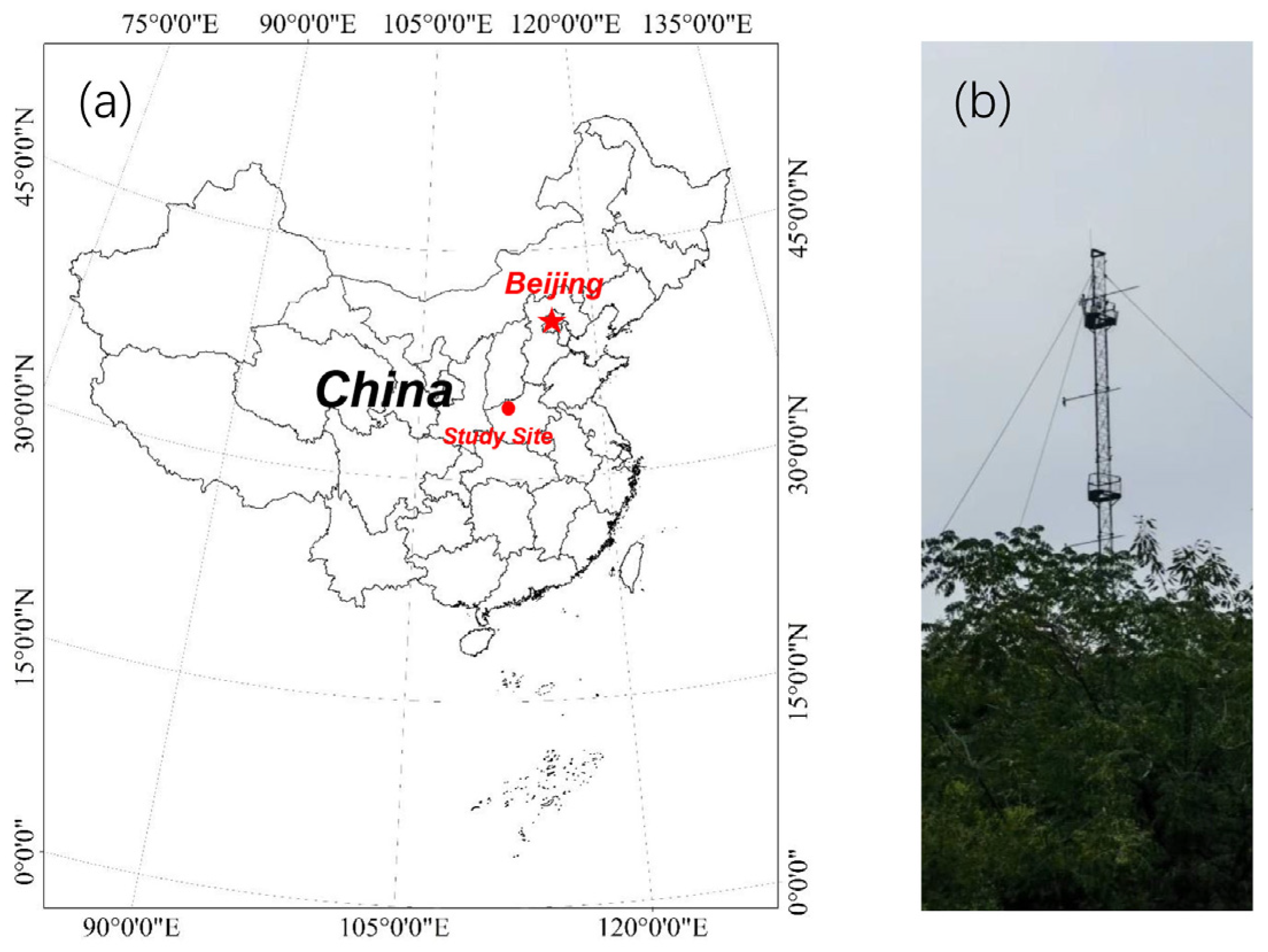


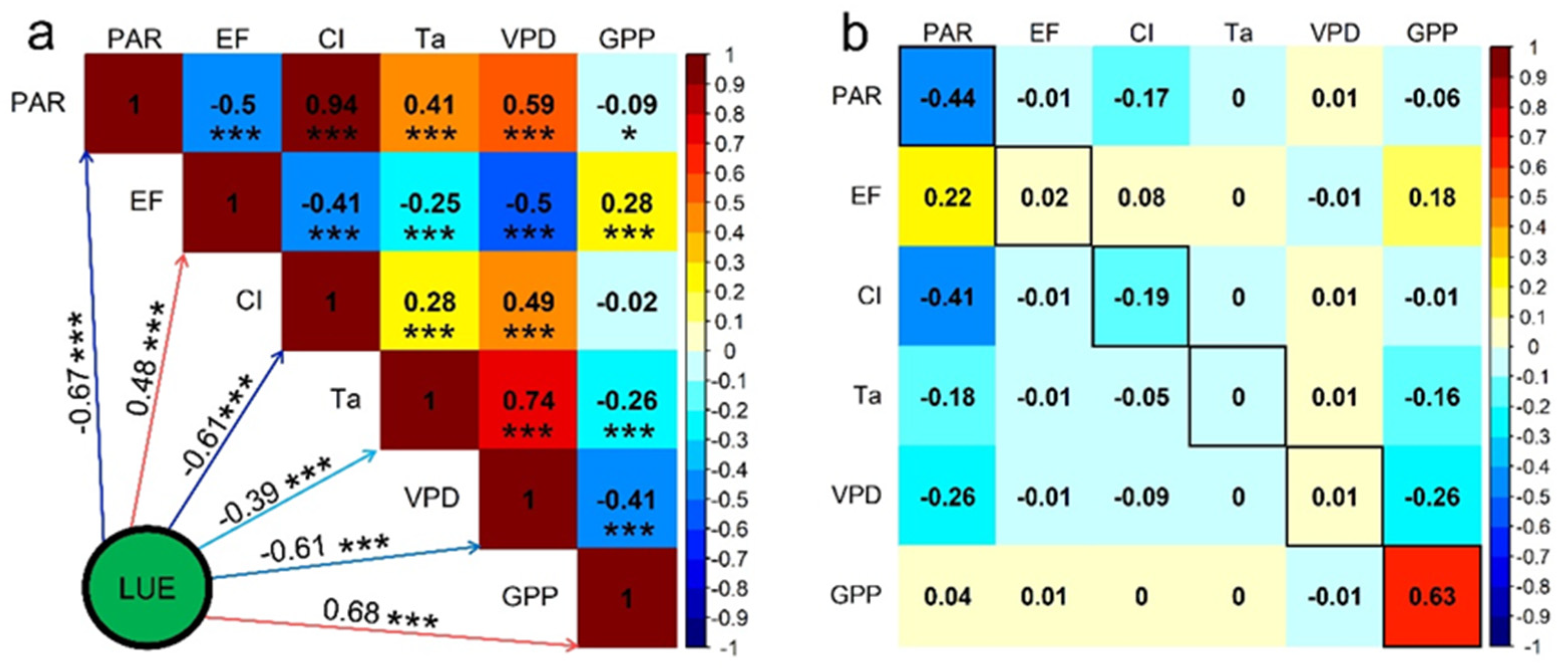

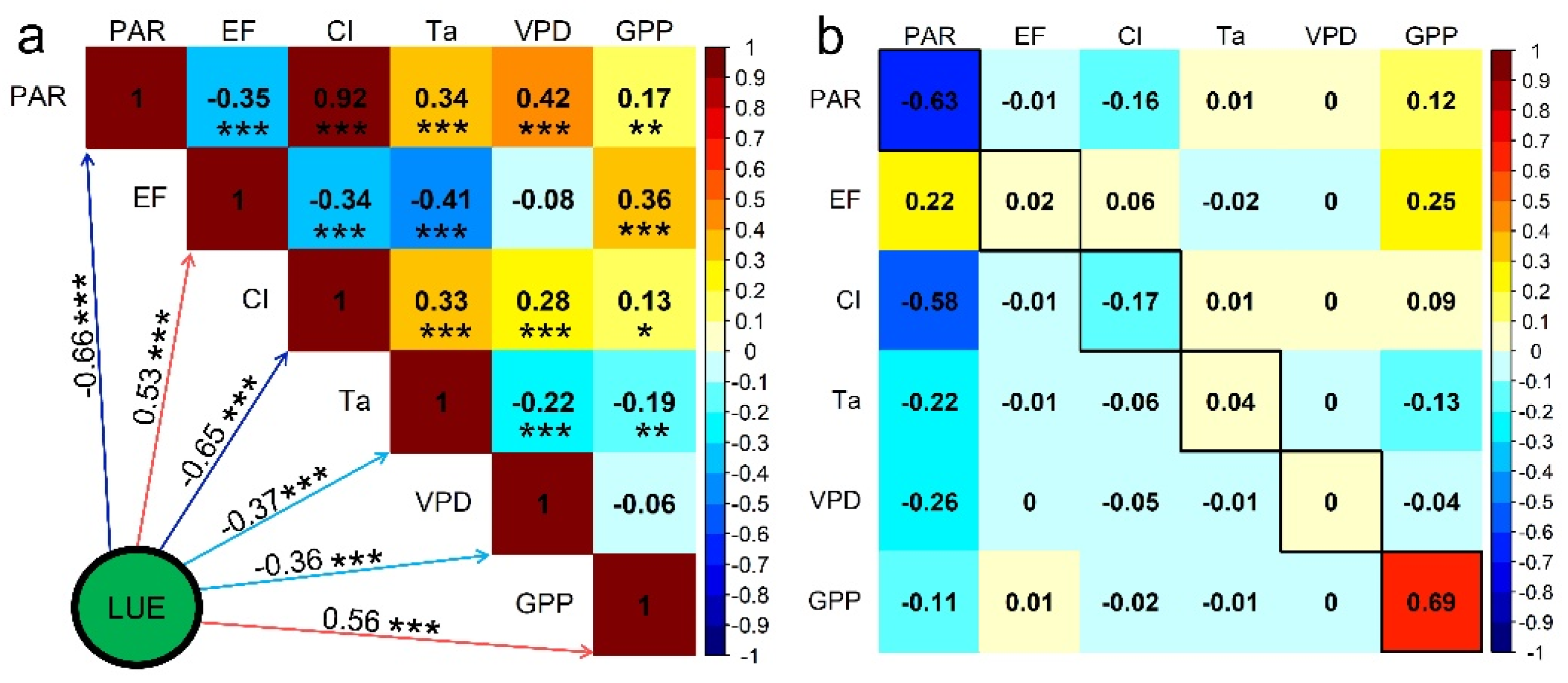
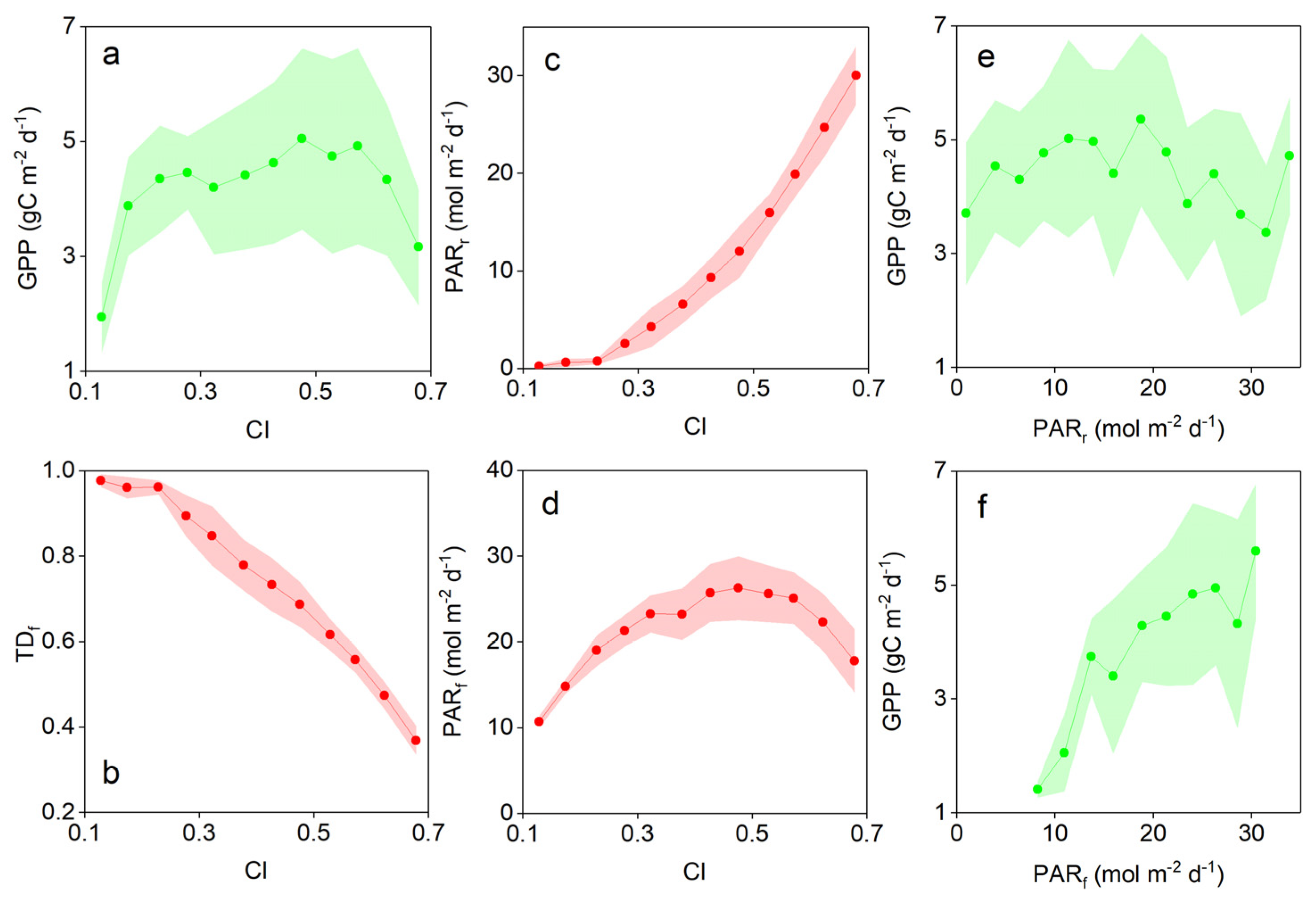
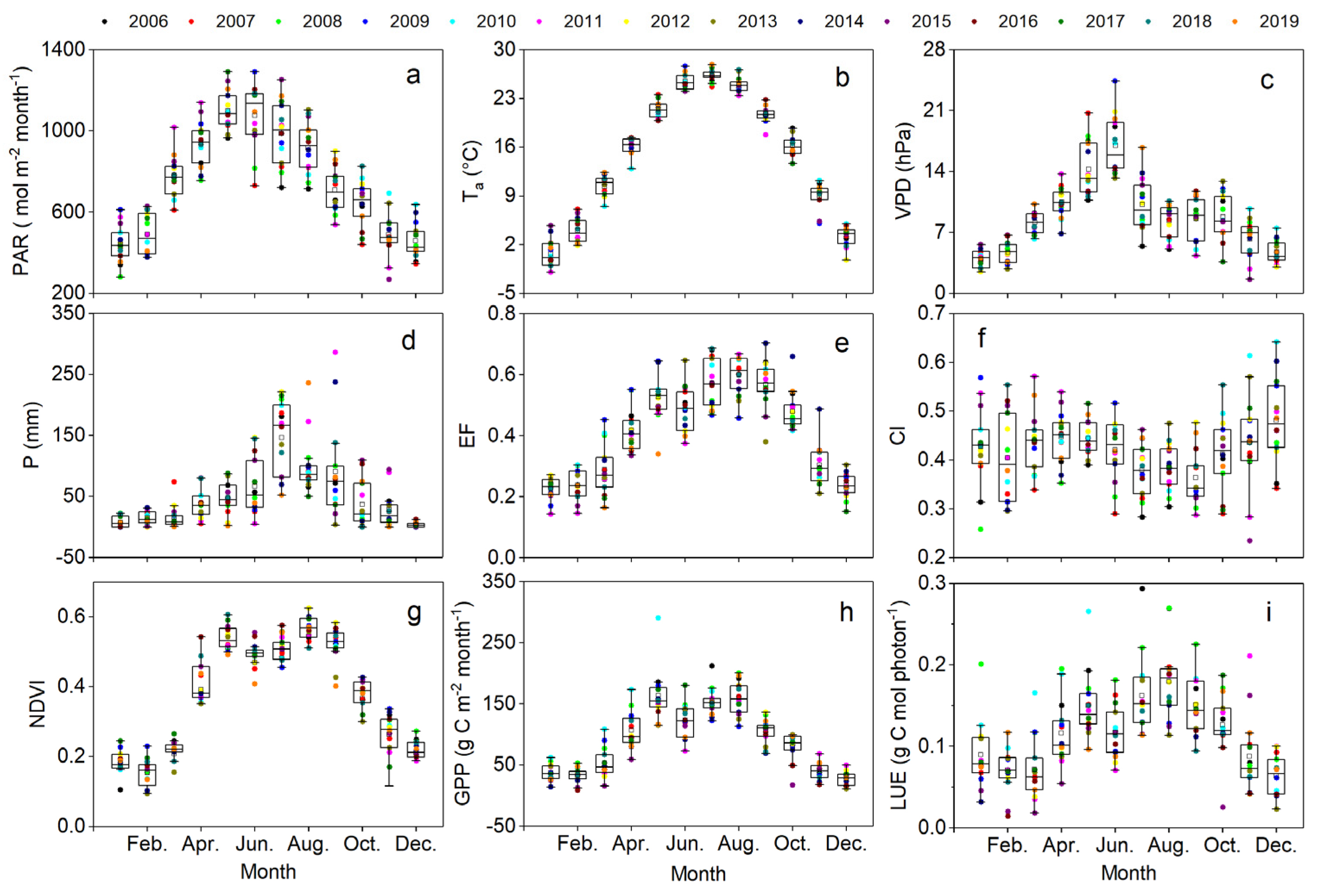
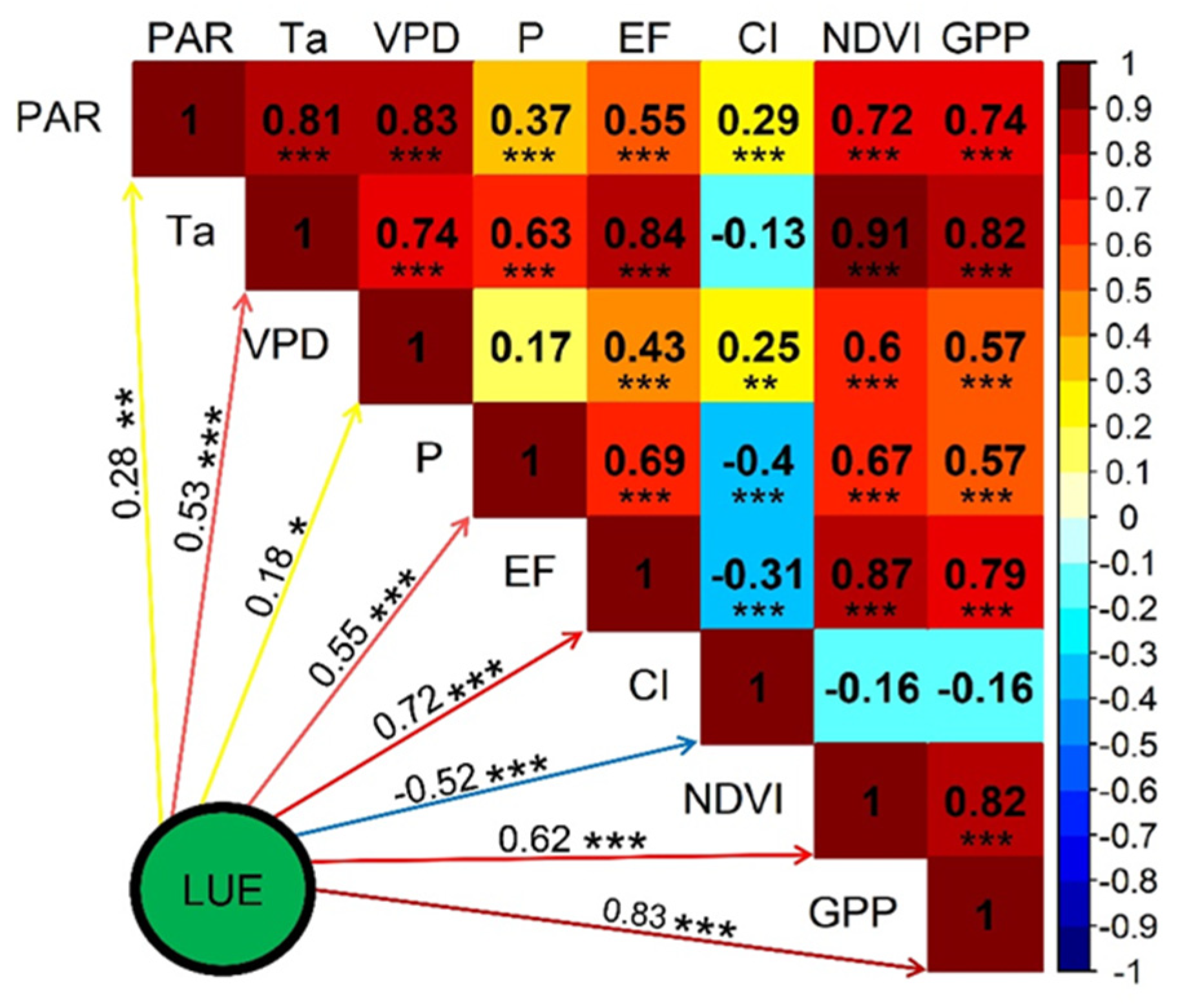
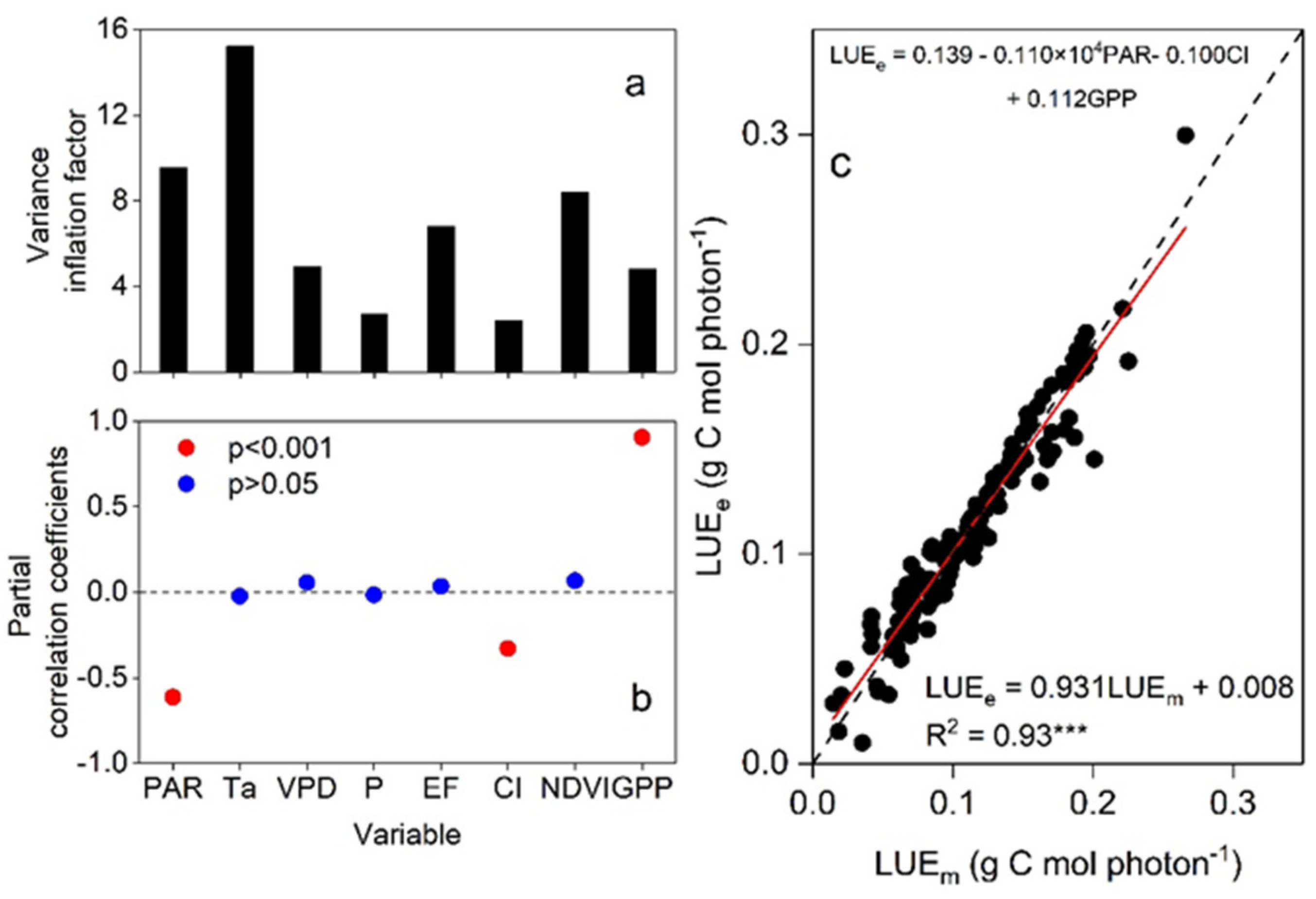
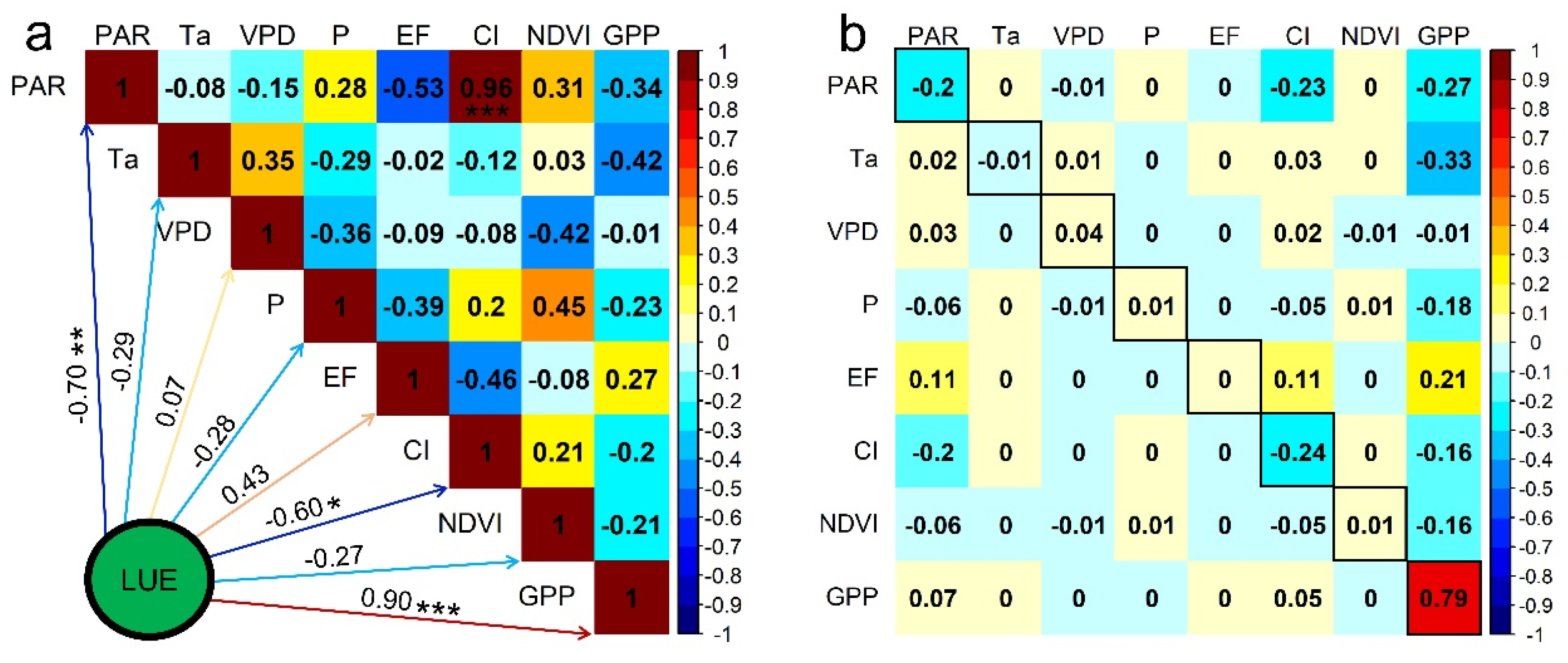
| Year | PAR (mol m−2) | Ta (°C) | VPD (hPa) | P (mm) | EF | CI | NDVI | GPP (g C m−2) | LUE (g C mol photon−1) | LUEmax (g C mol photon−1) |
|---|---|---|---|---|---|---|---|---|---|---|
| 2006 | 8048.67 | 15.03 | 8.49 | 559.70 | 0.45 | 0.37 | 0.37 | 1217.79 | 0.15 | 0.36 |
| 2007 | 7755.90 | 15.11 | 9.17 | 490.90 | 0.43 | 0.36 | 0.37 | 1036.66 | 0.13 | 0.31 |
| 2008 | 7670.72 | 14.64 | 9.19 | 600.10 | 0.42 | 0.36 | 0.37 | 1335.05 | 0.17 | 0.41 |
| 2009 | 9451.69 | 14.52 | 9.01 | 456.40 | 0.43 | 0.45 | 0.38 | 1090.35 | 0.12 | 0.36 |
| 2010 | 9212.84 | 14.26 | 8.13 | 512.10 | 0.43 | 0.44 | 0.37 | 1426.12 | 0.15 | 0.33 |
| 2011 | 9200.02 | 13.81 | 8.39 | 860.00 | 0.39 | 0.43 | 0.37 | 1059.85 | 0.12 | 0.27 |
| 2012 | 9792.10 | 14.38 | 9.02 | 613.30 | 0.41 | 0.45 | 0.38 | 1073.21 | 0.11 | 0.28 |
| 2013 | 8902.24 | 15.04 | 8.79 | 474.60 | 0.40 | 0.42 | 0.34 | 981.28 | 0.11 | 0.25 |
| 2014 | 9005.00 | 15.51 | 8.78 | 621.10 | 0.45 | 0.42 | 0.38 | 869.41 | 0.10 | 0.23 |
| 2015 | 9807.15 | 15.02 | 8.35 | 664.80 | 0.38 | 0.43 | 0.39 | 842.37 | 0.09 | 0.21 |
| 2016 | 9102.98 | 15.04 | 7.98 | 684.70 | 0.40 | 0.42 | 0.40 | 950.38 | 0.10 | 0.33 |
| 2017 | 9596.15 | 15.32 | 8.87 | 620.10 | 0.38 | 0.45 | 0.39 | 1156.96 | 0.12 | 0.38 |
| 2018 | 9527.76 | 15.12 | 8.87 | 686.20 | 0.41 | 0.45 | 0.38 | 1090.89 | 0.11 | 0.23 |
| 2019 | 9249.70 | 15.45 | 10.04 | 546.60 | 0.38 | 0.44 | 0.36 | 1038.20 | 0.11 | 0.29 |
| Mean | 9023.07 | 14.88 | 8.79 | 599.33 | 0.41 | 0.42 | 0.38 | 1083.47 | 0.12 | 0.30 |
Disclaimer/Publisher’s Note: The statements, opinions and data contained in all publications are solely those of the individual author(s) and contributor(s) and not of MDPI and/or the editor(s). MDPI and/or the editor(s) disclaim responsibility for any injury to people or property resulting from any ideas, methods, instructions or products referred to in the content. |
© 2024 by the authors. Licensee MDPI, Basel, Switzerland. This article is an open access article distributed under the terms and conditions of the Creative Commons Attribution (CC BY) license (https://creativecommons.org/licenses/by/4.0/).
Share and Cite
Gao, X.; Zhang, J.; Cai, J.; Meng, P.; Huang, H.; Sun, S. Effects of Biophysical Factors on Light Use Efficiency at Multiple Time Scales in a Chinese Cork Oak Plantation Ecosystem. Forests 2024, 15, 1620. https://doi.org/10.3390/f15091620
Gao X, Zhang J, Cai J, Meng P, Huang H, Sun S. Effects of Biophysical Factors on Light Use Efficiency at Multiple Time Scales in a Chinese Cork Oak Plantation Ecosystem. Forests. 2024; 15(9):1620. https://doi.org/10.3390/f15091620
Chicago/Turabian StyleGao, Xiang, Jinsong Zhang, Jinfeng Cai, Ping Meng, Hui Huang, and Shoujia Sun. 2024. "Effects of Biophysical Factors on Light Use Efficiency at Multiple Time Scales in a Chinese Cork Oak Plantation Ecosystem" Forests 15, no. 9: 1620. https://doi.org/10.3390/f15091620






